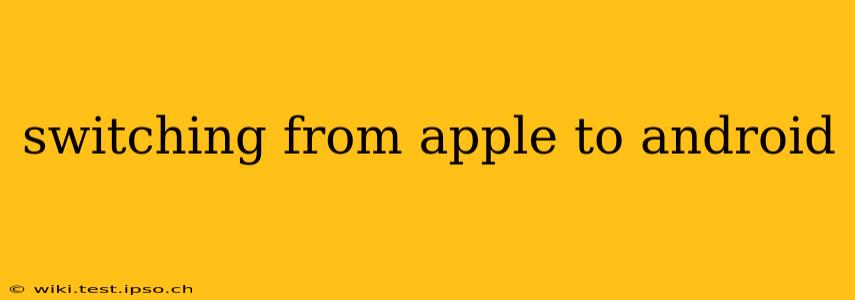Switching from the Apple ecosystem to Android can feel daunting, but with the right preparation and approach, it can be a surprisingly seamless experience. This comprehensive guide will walk you through the key steps, addressing common concerns and helping you make the most of your Android journey. We'll cover everything from transferring your data to exploring the differences between the two operating systems.
What are the biggest differences between Apple and Android?
This is a fundamental question many Apple users grapple with. The core differences lie in the operating systems themselves, their app ecosystems, and the overall user experience. Android offers greater customization options, while iOS is known for its simplicity and user-friendliness. The app stores also differ significantly, with Android boasting a wider range of apps (though not always of equal quality). Finally, the hardware landscape is much more diverse on Android, offering a wider array of price points and features.
How do I transfer my data from iPhone to Android?
Transferring your data is crucial for a smooth transition. Fortunately, Google has made this relatively easy with its built-in tools. The Google Drive app allows you to upload photos, videos, and documents for seamless transfer. Additionally, Google Photos provides a simple way to back up your entire photo library. For contacts, use the Google Contacts app. You can also utilize third-party apps designed specifically for this purpose, which often offer more comprehensive data transfer options. Remember to back up your iPhone data before you begin the transfer process.
What apps should I download first on my new Android phone?
This depends on your needs and preferences, but some essential apps include:
- Google Chrome: A powerful and versatile browser.
- Gmail: Google's email client, known for its efficiency.
- Google Maps: An indispensable navigation tool.
- Google Calendar: For managing your schedule and appointments.
- Google Drive: For storing and accessing your files.
- Google Photos: For backing up and organizing your photos and videos.
Beyond the Google suite, consider downloading apps that mirror your favorite iOS apps. Many popular apps have Android counterparts, but remember to check reviews before downloading.
Will my apps work on Android?
While many popular apps are available on both platforms, some apps may not have direct Android equivalents. Before switching, check if your essential apps are available on the Google Play Store. This is especially true for niche apps or those heavily integrated into the Apple ecosystem.
How do I get used to the Android interface?
Android's interface is significantly different from iOS. The most significant adjustment involves navigating the app drawer, utilizing the notification shade, and familiarizing yourself with different settings menus. Take the time to explore the settings and customization options. Android offers a high degree of personalization, so you can tailor the experience to your preferences.
Is it worth switching from Apple to Android?
Ultimately, whether switching is worthwhile depends on your individual needs and preferences. Android's flexibility and customization options might appeal to users who desire more control over their devices. On the other hand, iOS's simplicity and user-friendliness may be preferable for users who prioritize ease of use. Carefully weigh the pros and cons, considering your usage patterns and priorities before making the switch.
Can I use my Apple accessories with Android?
Many common accessories like headphones, charging cables, and external drives work with Android devices. However, some Apple-specific accessories, such as AirPods, will require additional steps or may not function optimally. Check compatibility before purchasing any new accessories.
This guide provides a starting point for your transition. Remember, patience and exploration are key to a successful switch from Apple to Android. With a little time and effort, you'll be enjoying your new Android device in no time.
